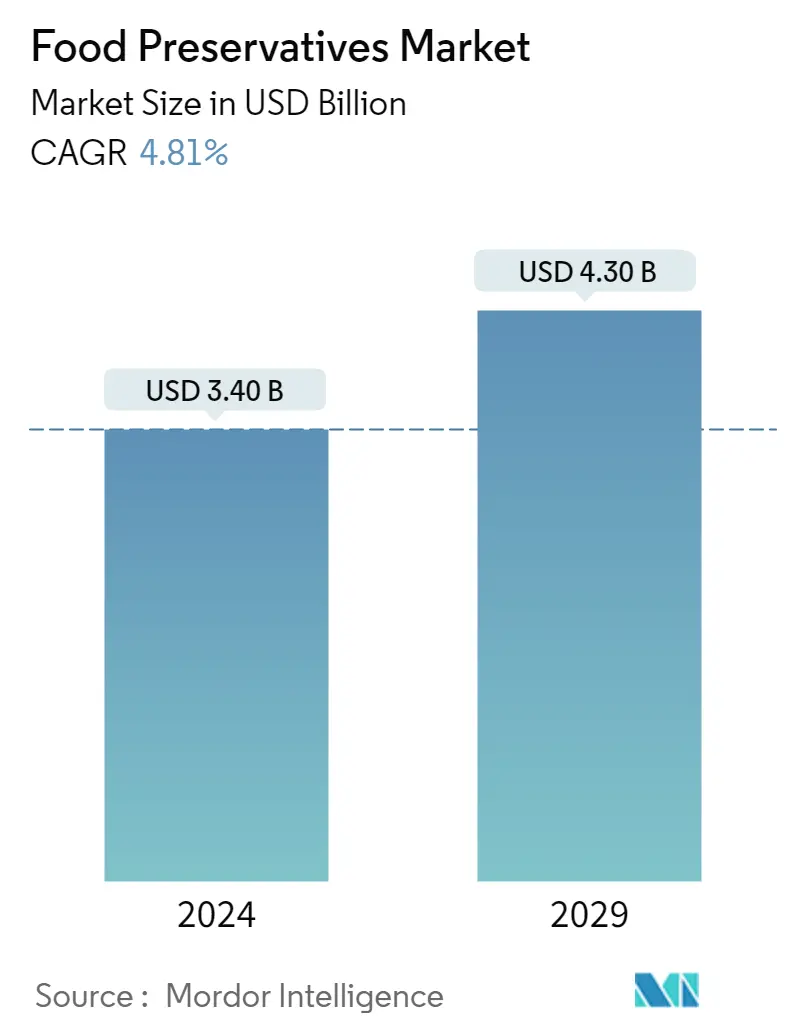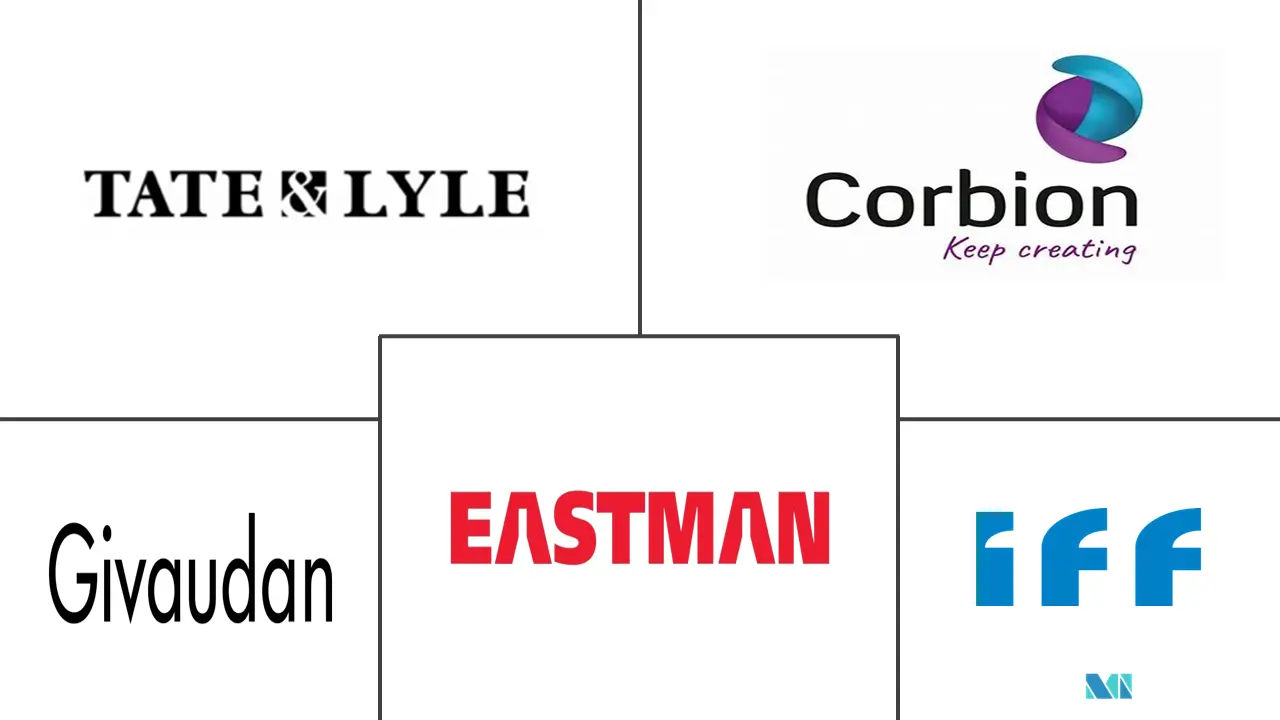Market Size of Food Preservatives Industry

| Study Period | 2019 - 2029 |
| Market Size (2024) | USD 3.40 Billion |
| Market Size (2029) | USD 4.30 Billion |
| CAGR (2024 - 2029) | 4.81 % |
| Fastest Growing Market | Middle East and Africa |
| Largest Market | North America |
Major Players
*Disclaimer: Major Players sorted in no particular order |
Food Preservatives Market Analysis
The Food Preservatives Market size is estimated at USD 3.40 billion in 2024, and is expected to reach USD 4.30 billion by 2029, growing at a CAGR of 4.81% during the forecast period (2024-2029).
The COVID-19 outbreak led to elevated sales of retail and long-shelf products across the global market due to restrictions on going out. Hence, the majority of the population across the world is engaged in stockpiling groceries and packaged food products for their households. This eventually had a positive impact on the industrial demand for food preservatives because of the rise in demand for processed food. Also, there has been a rise in the number of people who want ready-to-eat (RTE) meals, which has opened up new opportunities for companies that make food preservatives.
The strong correlation between the food preservatives market and the processed food market is driving the growth of the market, as there is a rise in the demand for processed food globally. The demand for food preservatives has gone up because they are used in more food industries.The antimicrobial and antioxidant properties of these food preservatives make them necessary for the food industry to make products last longer and stop bacteria from doing things they shouldn't.Sorbate, for example, is thought to be a good food preservative when it is used in a clean environment and in products that are made using good manufacturing practices.Sorbates are used a lot to make processed foods and drinks last longer. They are also used to make sausages, yogurt, cheese, cakes, and a lot of other things. Sorbates also stop different types, species, strains, substrate properties, and environmental factors from making microorganisms grow.Moreover, different regulatory agencies like the Food and Drug Administration, the Food and Agriculture Organization, and the European Food Safety Authority have put forward guidelines that say potassium sorbate is "generally regarded as safe", which is abbreviated as GRAS. The preservative doesn't accumulate in the body and passes through it.
The market is driven by the growing need for clean label solutions, the rising popularity of processed and packaged foods, and the complexity of the food industry's supply chain. The food preservatives market is likely to be driven by the growth of organized retail, especially in emerging markets. The major restraints on the market include the higher cost of natural preservatives (which are in higher demand) and consumer awareness of the side effects of synthetic preservatives. For example, Corbion NV increased its production of lactic acid and products made from lactic acid in March 2021 by working on expansion projects at the same time in Europe and other places.
Food Preservatives Industry Segmentation
Food preservatives are substances or chemicals that are added to foods and drinks to stop them from breaking down due to chemical reactions that aren't good.These substances hinder the growth of microbial action in food substances.
The food preservative market is segmented by type, application, and geography. By type, the market is segmented into antioxidants, antimicrobials, acidulants, and other types. Both antioxidants and antimicrobials are further categorized on the basis of their natural and synthetic forms. Based on application, the market is segmented as follows: bakery and confectionery; meat and poultry; ready meals; sweet and savory snacks; sauces and dressings; edible oils; and other applications. The market is segmented on the basis of geography into North America, Europe, Asia-Pacific, South America, the Middle East, and Africa. For each segment, the market sizing and forecasts have been done on the basis of value (in USD million).
| Type | ||||
| ||||
| ||||
| Acidulant | ||||
| Other Types |
| Application | |
| Bakery and Confectionery | |
| Meat and Poultry | |
| Ready Meals | |
| Sweet and Savory Snacks | |
| Sauces and Dressings | |
| Edible Oils | |
| Other Applications |
| Geography | |||||||||
| |||||||||
| |||||||||
| |||||||||
| |||||||||
|
Food Preservatives Market Size Summary
The food preservatives market is experiencing significant growth, driven by the increasing demand for processed and ready-to-eat meals globally. The COVID-19 pandemic has further accelerated this trend, as consumers stockpiled groceries and sought long-shelf-life products. This surge in demand for processed foods has created new opportunities for food preservative manufacturers, as these additives are essential for extending the shelf life and maintaining the quality of food products. The market is also influenced by the rising popularity of clean-label solutions, as consumers become more health-conscious and prefer products with natural ingredients over synthetic ones. Regulatory bodies have endorsed certain preservatives, such as potassium sorbate, as safe, which supports their continued use in the food industry.
The market landscape is highly competitive, with major players like Eastman Chemical Company, International Flavors & Fragrances Inc., Tate & Lyle PLC, Givuadan SA, and Corbion NV leading the charge in innovation and expansion. These companies are focusing on developing natural and clean-label preservatives to meet the growing consumer demand for healthier food options. The North American market, in particular, is witnessing a shift towards natural preservatives due to stringent regulations and consumer awareness. The fragmented nature of the market encourages collaborations and partnerships, as companies strive to enhance their product offerings and expand their global presence. The ongoing trend towards natural ingredients and clean-label products is expected to drive the market's growth in the coming years.
Food Preservatives Market Size - Table of Contents
-
1. MARKET DYNAMICS
-
1.1 Market Drivers
-
1.2 Market Restraints
-
1.3 Porter's Five Forces Analysis
-
1.3.1 Threat of New Entrants
-
1.3.2 Bargaining Power of Buyers/Consumers
-
1.3.3 Bargaining Power of Suppliers
-
1.3.4 Threat of Substitute Products
-
1.3.5 Intensity of Competitive Rivalry
-
-
-
2. MARKET SEGMENTATION
-
2.1 Type
-
2.1.1 Antioxidants
-
2.1.1.1 Natural Antioxidants
-
2.1.1.2 Synthetic Antioxidants
-
-
2.1.2 Antimicrobials
-
2.1.2.1 Natural Antimicrobial
-
2.1.2.2 Synthetic Antimicrobial
-
-
2.1.3 Acidulant
-
2.1.4 Other Types
-
-
2.2 Application
-
2.2.1 Bakery and Confectionery
-
2.2.2 Meat and Poultry
-
2.2.3 Ready Meals
-
2.2.4 Sweet and Savory Snacks
-
2.2.5 Sauces and Dressings
-
2.2.6 Edible Oils
-
2.2.7 Other Applications
-
-
2.3 Geography
-
2.3.1 North America
-
2.3.1.1 United States
-
2.3.1.2 Canada
-
2.3.1.3 Mexico
-
2.3.1.4 Rest of North America
-
-
2.3.2 Europe
-
2.3.2.1 Spain
-
2.3.2.2 United Kingdom
-
2.3.2.3 Germany
-
2.3.2.4 France
-
2.3.2.5 Italy
-
2.3.2.6 Russia
-
2.3.2.7 Rest of Europe
-
-
2.3.3 Asia-Pacific
-
2.3.3.1 China
-
2.3.3.2 Japan
-
2.3.3.3 India
-
2.3.3.4 Australia
-
2.3.3.5 Rest of Asia-Pacific
-
-
2.3.4 South America
-
2.3.4.1 Brazil
-
2.3.4.2 Argentina
-
2.3.4.3 Rest of South America
-
-
2.3.5 Middle-East and Africa
-
2.3.5.1 South Africa
-
2.3.5.2 United Arab Emirates
-
2.3.5.3 Rest of Middle-East and Africa
-
-
-
Food Preservatives Market Size FAQs
How big is the Food Preservatives Market?
The Food Preservatives Market size is expected to reach USD 3.40 billion in 2024 and grow at a CAGR of 4.81% to reach USD 4.30 billion by 2029.
What is the current Food Preservatives Market size?
In 2024, the Food Preservatives Market size is expected to reach USD 3.40 billion.

